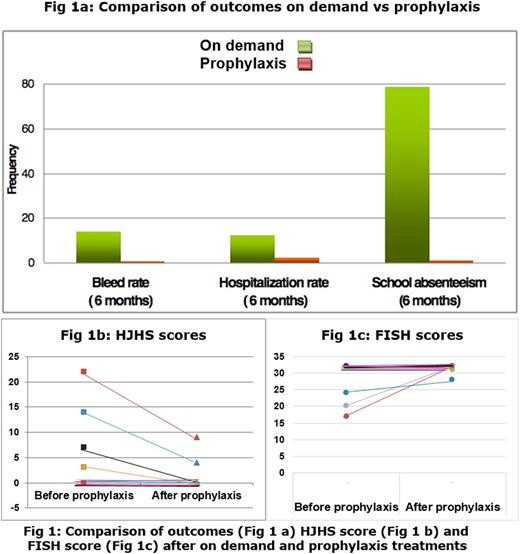Abstract
Prophylaxis for Hemophilia is globally accepted as a treatment strategy compared to on-demand therapy in the care of persons with hemophilia (PwH) . Prophylaxis is rarely practized in low and middle income countries due to several reasons such as ill-affordability of clotting factor concentrates ( CFCs), lack of awareness, absence of comprehensive / home care infrastructure and misconcepts regarding treatment among general population.
The South Indian state of Kerala had been providing CFCs free of cost for on-demand treatment. A recent initiative was started in Hemophilia Treatment Centre(HTC), Aluva , Ernakulam district to provide secondary/tertiary prophylaxis free of cost to children with severe hemophilia (Factor level <1%, aged 5-15 yrs) as a joint effort from HTC and the local government.
A clinical audit was done in 11 children at this center for a period of twelve months (6 months retrospectively for on-demand treatment and 6 months prospectively for prophylactic treatment). Among all patients with severe hemophilia, eight have Hemophilia A and the remaining three have Hemophilia B. They were previously treated with CFCs/plasma/cryoprecipitate, a few of them had established joint disease and all of them had absence of inhibitors. These children were initiated on low dose prophylaxis with plasma derived CFCs. Factor VIII concentrate was given at a dose of 20-40 U/kg in 2 divided doses per week for Hemophilia A and Factor IX concentrate at 25-40 U/Kg once a week for Hemophilia B. Outcomes were measured at two time points - at the end of secondary/tertiary prophylactic treatment period and at the end of preceding six months of on-demand treatment. The variables taken as outcome measures were changes in bleed rates, Hemophilia joint health score (HJHS), Functional independence score in Hemophilia (FISH), hospitalization rates and school absenteeism.
A reduction in the bleed rate was seen from the transition of on demand treatment to secondary/tertiary prophylactic treatment (14.9 vs 0.91, p 0.005). Similar reductions were seen for hospitalization rates (12.45 vs 2.36 days, p 0.005) and school absenteeism (78.55 vs 1.27 days, p 0.01) respectively(Fig 1 a). FISH and HJHS scores were either maintained or improved during the prophylaxis period.(Fig 1b, 1c). None of the children developed inhibitors during the study period. The estimated cost of CFCs for on demand treatment per patient was 1314.4 USD and 1691.8USD during prophylaxis. The factor consumption for on demand treatment for 6 months was 968.24 IU/Kg and that of secondary/tertiary prophylaxis was 1077.96 IU/Kg respectively.
We conclude that low dose prophylaxis for severe Hemophilia in a developing economy is feasible and has marked clinical benefits with greater well-being when compared to on demand therapy. In countries with resource constraints low dose secondary/tertiary prophylaxis should be considered as a therapeutic option over on demand therapy for children with severe Hemophilia in the light of its potential benefits .
No relevant conflicts of interest to declare.
Author notes
Asterisk with author names denotes non-ASH members.


This feature is available to Subscribers Only
Sign In or Create an Account Close Modal